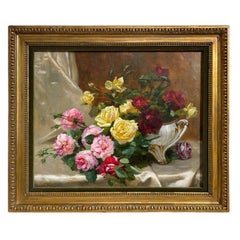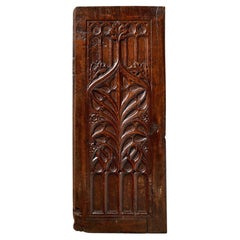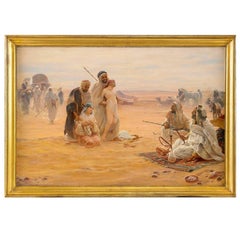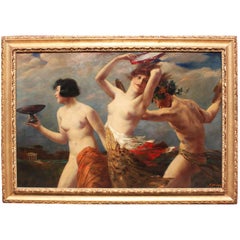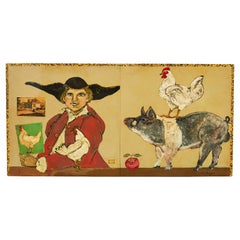Wood Decorative Art
Late 19th Century French Antique Wood Decorative Art
Canvas, Giltwood
16th Century English Tudor Antique Wood Decorative Art
Wood, Oak
Early 20th Century Swiss Islamic Wood Decorative Art
Giltwood, Canvas
Early 20th Century German Greco Roman Wood Decorative Art
Canvas, Giltwood
Early 2000s American Wood Decorative Art
Wood, Paper
20th Century American French Provincial Wood Decorative Art
Canvas, Acrylic, Wood
1790s French Louis XVI Antique Wood Decorative Art
Giltwood
19th Century Japanese Edo Antique Wood Decorative Art
Wood, Paper
Late 20th Century Neoclassical Wood Decorative Art
Hardwood, Lacquer
Mid-19th Century Antique Wood Decorative Art
Wood
19th Century French Napoleon III Antique Wood Decorative Art
Wood
1950s Haitian Tribal Vintage Wood Decorative Art
Wood, Masonite, Paint
Late 18th Century English Tudor Antique Wood Decorative Art
Silk, Thread, Glass, Giltwood
20th Century American Classical Wood Decorative Art
Wood
Early 1900s German Black Forest Antique Wood Decorative Art
Antler, Wood
20th Century German Wood Decorative Art
Wood, Paper
1960s French Mid-Century Modern Vintage Wood Decorative Art
Wood
1990s American American Classical Wood Decorative Art
Glass, Wood, Paper
Late 19th Century Swiss Black Forest Antique Wood Decorative Art
Wood
2010s Colombian Wood Decorative Art
Malachite
Late 20th Century Country Wood Decorative Art
Canvas, Mahogany
1930s French Mid-Century Modern Vintage Wood Decorative Art
Wood
Early 20th Century European Art Deco Wood Decorative Art
Plaster, Wood
1940s Asian Mid-Century Modern Vintage Wood Decorative Art
Gold
20th Century Dutch Wood Decorative Art
Porcelain, Oak
1950s French Mid-Century Modern Vintage Wood Decorative Art
Wood
1930s German Country Vintage Wood Decorative Art
Wood
1970s American Modern Vintage Wood Decorative Art
Wood, Paint
1960s American Hollywood Regency Vintage Wood Decorative Art
Wood
20th Century Unknown Modern Wood Decorative Art
Hardwood
Late 20th Century Asian Wood Decorative Art
Metal
Late 19th Century English Late Victorian Antique Wood Decorative Art
Gesso, Glass, Wood, Paper
Mid-19th Century English Jacobean Antique Wood Decorative Art
Wood, Oak
20th Century Aesthetic Movement Wood Decorative Art
Canvas, Wood
Late 18th Century French Empire Antique Wood Decorative Art
Mirror, Giltwood, Pine
1970s Italian Mid-Century Modern Vintage Wood Decorative Art
Teak, Pine
18th Century Swedish Gustavian Antique Wood Decorative Art
Glass, Mirror, Giltwood
1930s German Black Forest Vintage Wood Decorative Art
Antler, Wood
15th Century and Earlier Spanish Medieval Antique Wood Decorative Art
Parchment Paper, Wood
19th Century Italian Renaissance Antique Wood Decorative Art
Wood, Paint
Late 20th Century Dutch Modern Wood Decorative Art
Metal
20th Century Unknown Wood Decorative Art
Wood, Paper
1950s American Japonisme Vintage Wood Decorative Art
Glass, Giltwood
18th Century Italian Baroque Antique Wood Decorative Art
Canvas, Giltwood
Late 20th Century Spanish Wood Decorative Art
Ceramic, Wood
Early 20th Century Italian Grand Tour Wood Decorative Art
Canvas, Giltwood
1960s American Mid-Century Modern Vintage Wood Decorative Art
Fabric, Felt, Wood
1860s German Biedermeier Antique Wood Decorative Art
Glass, Wood
19th Century American Victorian Antique Wood Decorative Art
Wood, Pine
18th Century Italian Rococo Antique Wood Decorative Art
Gold Leaf
1890s Dutch Antique Wood Decorative Art
Wood, Porcelain
2010s Italian Other Wood Decorative Art
Wood
Mid-20th Century French Mid-Century Modern Wood Decorative Art
Canvas, Wood, Paint
18th Century and Earlier Italian Renaissance Antique Wood Decorative Art
Gold Leaf
1940s Vintage Wood Decorative Art
Fabric, Oak
1960s Spanish Mid-Century Modern Vintage Wood Decorative Art
Ceramic, Wood
1960s Mexican Modern Vintage Wood Decorative Art
Wood, Paper
Early 19th Century French Empire Antique Wood Decorative Art
Giltwood, Paint
Mid-19th Century French Antique Wood Decorative Art
Wood
Mid-19th Century English Romantic Antique Wood Decorative Art
Cork
Read More
At Colonial Williamsburg, Everything Old Is New Again
With the help of a new director, the Virginia institution's folk art and decorative arts museums are undergoing extensive upgrades.
New York’s Hirschl & Adler Showcases the American Workmanship and Design Panache of Neoclassical Treasures
The gallery's latest exhibition proves that museum-quality pieces entice and inspire, whether in traditional or more modern interiors.
